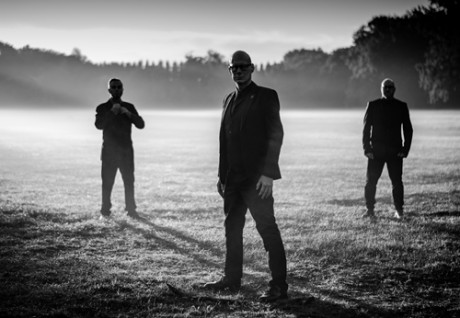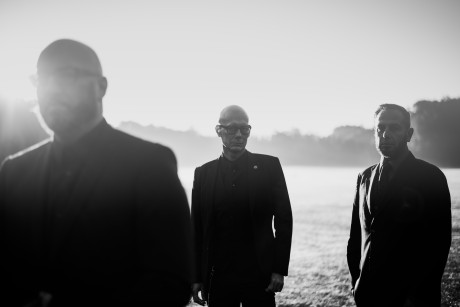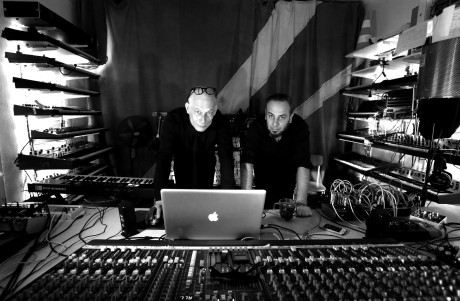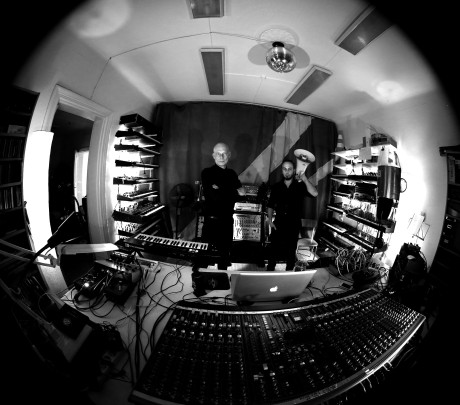
Welcome to the void – A conversation with Covenant
Posted In Interviews,Slider by Fredrik Schlatta Wik
Covenant’s ninth studio album, “The Blinding Dark” is here. Fredrik Wik from Release met Eskil Simonsson and Joakim Montelius in their studio in Helsingborg, Sweden, a dark autumn evening in October 2016 for an interesting in-depth interview. The article contains exclusive photos, taken by Fredrik earlier 2016.
The forces of darkness
Eskil had just flown back from the US and the start of “The Blinding Dark” tour, spanning a growing number of dates this autumn and winter was imminent.
Having been granted access to the material of the album, both music and artwork, I had the pleasure of listening to the album well in advance and forming my own thoughts about it without reading other interviews or reviews.
The album consists of eleven tracks of which there are two shorter interludes, an intro and cover, a rare thing when it comes to Covenant lore. The album comes in more versions than usual: Standard CD, double CD, triple vinyl and a box where you get everything in addition to a digital release on all major distributing channels.
ES: It is the most ambitious release yet, we wanted to give our listeners the chance of selecting the format they prefer, be it with our without the bonus material like the “Psychonaut EP” and the luxurious 48 page hard cover booklet in 7 inch format. Also, nowadays sales figures for the chart positions are also based on gross income so a box is more worth than the standard edition in that regard. We have made everything ourselves, from the artwork in close co-operation with Covenant family member Tobias Green, who is also playing bass on “If I Give You My Soul”, to the production of the songs.
With two interludes and the intro, the total album playing time is just over 45 minutes, which is fairly short for Covenant?
ES: We kept the standard album short in order to maximize the sound quality of the vinyl edition, where you need space for the grooves, and to maximize and optimize the dynamic range of the album.
Why did you name the album “The Blinding Dark”?
JM: The book “Det bländande mörkret” by Owe Wikström translates roughly into “The Blinding Dark”, although it sounds more poetic in Swedish. We bought it and I scanned through it and found a bit too Christian for my taste.
ES: Well, Wikström is a man of the cloth. It has an interesting section, which is a history of the mysticism of Christianity. For me it is a good starting point of learning more about spiritualism. In retrospect the book doesn’t have so much to do with how the album turned out, apart from being a trigger and providing the title.
JM: The album has a spiritual level of course…
And not only lyrically but also music-wise?
JM: Yes, and that was the starting point for the creation of the “Psychonaut EP”, the totally improvised bonus material for the album. There are references to chaos magic and modern shamanism in there.
ES: We met a couple of times for jam sessions, to play everything live there and then. It is only afterwards that I realized that it could be thought of as some sort of modern shamanism. For me it was a deep spiritual experience. We recorded eight hours in a cabin in the woods, which I cut down to one. The title is from the books “Liber Null and Psychonaut: An Introduction to Chaos Magic”, by the occultist Peter J. Carroll. But we don’t practice any dark magic rituals of course, but it is interesting to learn more about it. It provides pieces of the puzzle that forms the world we live in. Rodney Orpheus of The Cassandra Complex graciously wrote the preface to “Psychonaut EP” and he has previously written a book on the magick of Aleister Crowley called “Abrahadabra”.
Did any of the jam session parts end up on the album as backgrounds or is it exclusively on the bonus EP?
JM: Only on the EP.
ES: It was a nice experience and by improvising live, you wander a bit into the unknown and are not in total control. That feeling along with Joakim’s lyrics about trucing in the dark formed a unified theme for the album. Not knowing what the future holds and being scared of that, and realizing that it is totally OK to be afraid.
JM: And there a few references to the forces of darkness on the album. There is a monopoly of what is right and what is wrong in organized religion and even in a secular country like Sweden these are still the governing precepts. We want to say that we still can choose freely; you have to think for yourself. Perhaps the lyrics of the song “Morning Star” are the clearest example of this.
ES: I visited an exhibition with the works of Mondrian. He was very much into mysticism and reduced the perception of God into something very abstract; blocks and lines of different colours. For us, this has always been a subject for discussion. I want to learn more about theosophy. And the darkness.
JM: Just look at the some of the current albums like Leonard Cohen’s “You Want It Darker”; there is lot of darkness in our society right now and our album, and other artists’ albums, also reflects that.
ES: But it is also a hopeful album.
Oh, I think it is your darkest album yet.
ES: Yes it is, but it has a strength and defiance. It is not all darkness. There is no resignation. I look at it as a triumph. It will be very interesting to see the reception of the album. It is a clear departure from our previous albums which perhaps were more focused on club anthems.
JM: For me it is important to state that it is not a hopeful album for me. I don’t like the concept of hopefulness.
Is the darkness coming from you or is the world truly dark?
ES: It is a reflection on what is going on around us right now mixed with our own experiences. When we grew up, with the iron curtain and Berlin wall, the future was quite dystopian, and that feeling is growing again.
JM: I knew for sure I wouldn’t get to be 25 and that mind-set is again with me. When we did “United States of Mind” it was different, it is a very optimistic album and for a couple of years I thought it might be alright after all. There was a positive vibe about globalization that is totally gone now.
What went wrong?
JM: A number of things. 9/11… As I see it, it went from poor to good to even worse.
ES: I agree with professor Hans Rosling, the world is better off now, at least from an environmental point of view.
JM: True.
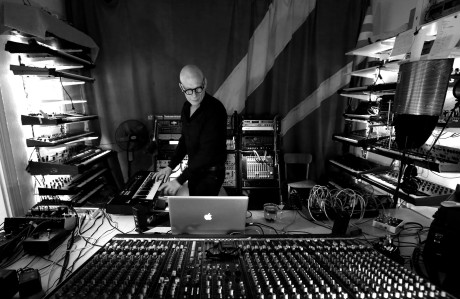
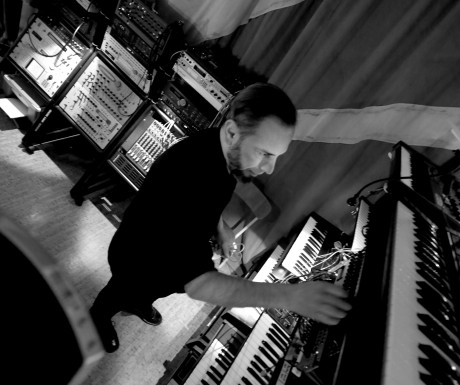
Click the pics for larger versions.
Living the album
Tell me about the process of creating an album.
ES: It is very painful process. It is like standing at the edge of the ten meter diving board for half a year and then having the record company pushing you over the edge and a have a freefall of one month where you do most of the work.
JM: We try to be disciplined and for some people that comes very naturally. For us it doesn’t. I need to be a bit miserable to do any work. We need that freefall to be productive. Five days before deadline we fix everything, in total panic with no sleep, that’s where it all comes together.
So you live the album?
JM: Yes exactly, right here right now. Don’t look back or forward, being present in the present. Create.
Does the album reflect who you are?
JM: Yes, who we are and feel right now. Every record is like a snapshot; if I wanted to know how I felt in 1998 I listen to “Europa”.
ES: What songs are defining the album for you?
“Morning Star”. For me it is the distilled essence of the album, soundwise, lyrically and thematically. What do you think?
JM: “Morning Star” summarizes the concept, and that is not on purpose. It just happened to be like that.
ES: Yes, it catches much of the freefall. I like the defiance in the lyrics and the anti-authority of it. I like the force and the pulsating feel of it. It is the first song Joakim have written completely in 20 years or so.
A growing Covenant family
Generally you write the lyrics, Joakim, and you do the arranging Eskil, right? But reading the booklet this album is a bit different?
ES: Yes usually, but for this album we are quite few who have contributed and for the previous two we have a growing family of Covenant. We are now a five piece including Andreas Catjar, Daniel Jonasson and Daniel Myer. I do less and less on the albums. I have around ten songs from different collaborators waiting to be the next Covenant album, or a side project perhaps. There is a track with Kirlian Camera, which is going to be a monster hit.
JM: We have opened up what used to be a quite dogmatic process and are very inclusive now. Ever since Clas left we have a different approach to making music.
ES: It is a very private process making a record; it feels good that we are more inclusive nowadays. I for one embrace it.
JM: Yes and with our way or working on separate bits and pieces and making electronic music it is inherently lonely. It is nice then to be more open. Eskil and I find it difficult to co-operate closely in the studio and if we have different opinions it usually ends with us being bitter and quiet. So we use a number of hard drives and the internet, giving us lots of freedom in place and time.
You even have a cover on the album, “A Rider on a White Horse” by Lee Hazlewood, in co-operation with Erica Li.
ES: Andreas Catjar and Erica Li have the band Lovac and Erica did the track on her iPad urged by Andreas and they asked me if I wanted to sing.
And the theme of the song is very suited for the album. Is it biblical?
JM: The theme is not biblical really. It is from the novel “Der Schimmelreiter” by Theodor Storm, written in the late 19th century. It is a sad story about a man who builds dykes in Holland, a ghostly rider on a skeleton horse, lost love and storms.
ES: On our last album we had a song, or a new interpretation of a song rather, “Not to Be Here” by dimbodius and maybe this new project will be a collection of new songs or old material mixed in a new way. Ten years ago it would have been unthinkable for us to do a Lee Hazlewood cover, although Joakim has been nagging me to do the Emmylou Harris song “Deeper Well” for quite some time.
JM: “Der Leiermann” is something of a cover… and some of the lyrics of “Dies Irae” on this album are from the translation of the ancient Latin hymn by William Josiah Irons.
It feels like you spent a great deal of time on the song order and the interlude placement?
ES: Interludes are a great way of breaking up the various sub-themes of the album song order and the interludes form a vorspiel of what is to come next.
JM: Many classic albums have them and we have a lot of short snippets that we haven’t developed into a full sound but in this case, particularly the interlude from Daniel Jonasson, we felt that it was finished as it was, perfect in the this micro format. They are not there as fillers, they do have a function.
ES: Daniel Jonasson is a very accomplished musician and I tried adding vocals to it but it felt like it was finished. He has a very direct approach to making these short songs, he makes them and records them and then turn everything off, so it is impossible to recreate it exactly, and I like that, it gives the album a live, unfiltered feel. We have tried a similar approach on other tracks.
The record has a theme but it is very varied, but in the musical styles but also how the vocals are arranged, is that deliberate?
ES: I would perhaps like it more homogenous, but then you have to add more filters. I tried to develop things further on a few tracks but it ended up being worse than the original but in some cases we kept the alterations. We have material for years to come. The difficulty is selecting the various embryonic projects to form any kind of coherent record. This time we succeeded and having the album title early in the process influenced the theme and tone more than any previous record, apart from maybe “Sequencer” where we also had a firm idea. We controlled everything, every single filter and sound from the Atari, everything is possible to reproduce exactly as it is on the record.
Are there two kinds of Covenant fans, the album and club anthem fans and those who like to B-sides and the more industrial and experimental parts?
JM: Yes, I think so…
ES: I think our hardcore Covenant fans are the album fans. If you like our B-sides and other stuff you probably like that kind of music in general. It is a necessity to release varied music for us, I love the clap-along fists in the air club anthems, but in order to do that and develop new sounds you have to make music that aren’t so streamlined. “In Theory” is perhaps my all time favourite song.
One world
Do you know already in the studio that a song is going to be a hit?
JM: Yes, after doing this for a quarter of a century we rely on our intuition and we are often right. We are driven emotionally and sometimes it happens really fast, spontaneously. We can’t really sit down and make the decision to make a single song, although it is known to happen. The nice thing about this album is that you have to read between the lines. The gigantic romantic standing on a cliff in the alps-feel is present, but is unspoken in a way. It would destroy the magic of the album if we took it all the way. I can’t see any other track than “Sound Mirrors” as a single.
What is the story behind “Sound Mirrors”?
ES: Joakim contacted artist and sound engineer Tim Shaw who had made recent recordings of airplanes in Fulwell using sound mirrors, this precursor to radar. A sound mirror is a large concrete ear capturing sounds and amplifying them. They were developed pre WWII to provide early warning of incoming aircraft. Tim Shaw’s recordings were part of a project focusing on various surveillance techniques. We got the original recordings and I reversed one of them to make the intro to the album as an introduction of what to come. Like the feeling of the unknown and the fear of not knowing what will happen. That feeling of being scared, in the dark, progresses through the entirety of the album. It’s a modern version of the greek Catharsis drama if you will.
Is this where your hopefulness comes in?
ES: Yes, in a way. You find that you are still scared after going through the emotions but it is OK to be afraid. It is not totally stringent with our anti-authority ideas but the base emotion is the same. Do not give in.
JM: Embrace your fear.
The song “Sound Mirrors” is unique in regards to making a political statement.
JM: Covenant is a non-political entity and always has been. But in this case we made an exception. The current state of the world, with refugees being mistreated and a we versus them attitude can’t go on. As I stated on our website: There is no we versus them. There is only us. And there is only one world.
My oldest daughter described the sounds of the intro to “Sound Mirrors” as ghosts and owls, what are they really?
JM: The owls are sampled sonar sounds, pitched down to mimic submarine sonar. I don’t really understand what she means by ghosts. The clicking rhythmic part is a clipped drum sample.
Your music evokes a lot of references for me, for instance, when listening to “If I Give You My Soul” the vocals sounds like Gary Numan to me; the inflections, and melody. Is that a conscious thing?
ES: No, but I like the comparison, thank you. I get inspiration from all the music I listen to, which is a lot, and some of it undoubtedly ends up on our records. I assimilate everything. It is usually a good thing if it reminds you of something but isn’t exactly the same. Last year I listened to 1 000 different albums.
Could you describe the technical aspects of the music in the song “Morning Star” for us techno geeks out there?
JM: The drone sounds and the bass are Yamaha CS-30, Korg MS-20 and Moog Voyager, sequenced and modulated with Analogue Solutions Oberkorn, Electro-Harmonix 8-step Program and the internal sequencer of the CS-30. The drone sounds are filtered through a Roland RE-301, adding chorus and echo and is distorted using the signal in. The main beat is from a d16 Group Nepheton (TR-808) put through a spring-reverb and tube overdrive. The extra kick drum is a sample from a soft synth, can’t remember which, and the swishy kick beat is the most iconic rock beat of all time, receiving a brutal make-over in a DSI Evolver. The atonal chord progression is from the Native Instruments Kontakt library Kinetik Metal and Waldorf Nave. Eskil did the arpeggio melody, using a preset of some Arturia soft synth.
As final words, what message would you like to relay to our readers?
JM: Welcome to the void.
Joining us for this interview: Johan Arenbo (Zero)
Studio photos by: Fredrik “Schlatta” Wik (Release)
Outdoor photos by: Chris Ruiz

